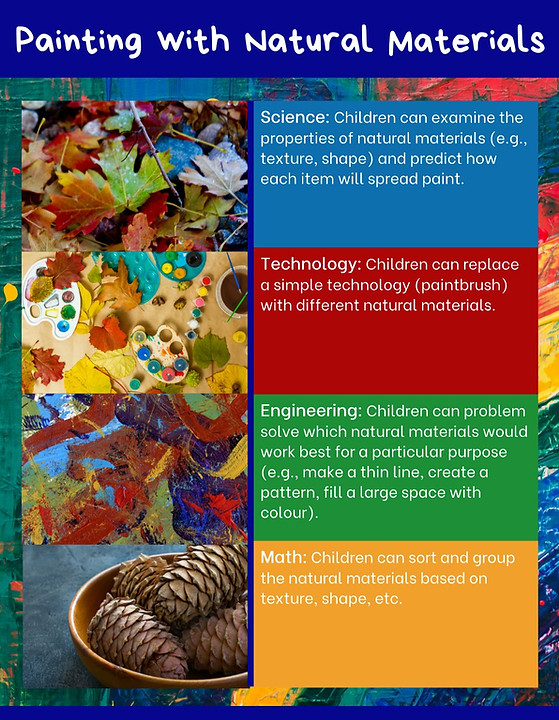

Age
⚙ 2 years and up
Time and Place
⚙ Any time of day
⚙ Any time of year, depending on availability of natural materials
⚙ Indoors or outdoors (weather permitting)
Materials
⚙ Natural materials for painting (e.g., leaf, stick, stone, pinecone)
⚙ Non-toxic tempera paints
⚙ Paper
Optional Materials
⚙ A bag or container to collect natural materials
Safety
⚙ Supervise children at all times
⚙ Be aware of choking hazards (e.g., small stones, acorns)
⚙ If outdoors, protect children from elements (e.g., sun, rain)
Instructions
When children demonstrate an interest in painting, encourage them to suggest other things they could use instead of a paintbrush. Go outside – maybe on a nature walk – and challenge the children to collect natural materials they could use as paintbrushes. Leave animals, growing leaves and flowers, and attached sticks alone. Talk about how the different materials can be used to paint. Place paper and several colours of paint on a table or other flat surface. Let the children explore the natural materials and paint freely.
Questions You May Ask
⚙ What else can you use instead of a paintbrush?
⚙ What natural materials can you use to paint?
⚙ How might you sort your natural materials?
⚙ How does the [stick, rock, pinecone] feel?
⚙ If you were to paint with the [leaf, stone, stick], what kind of mark would it make?
⚙ Which materials would work best to [make a line, create a pattern, fill in space]?
Play-based Context
A group of young children was really enjoying painting and mixing colours. The camp leaders took the children outside to find natural materials to paint with. The children and camp leaders all had fun painting outside creating unique artwork

Related Children's Books
⚙ Beautiful Oops! By Barney Saltzberg
⚙ Not a Stick by Antoinette Portis


